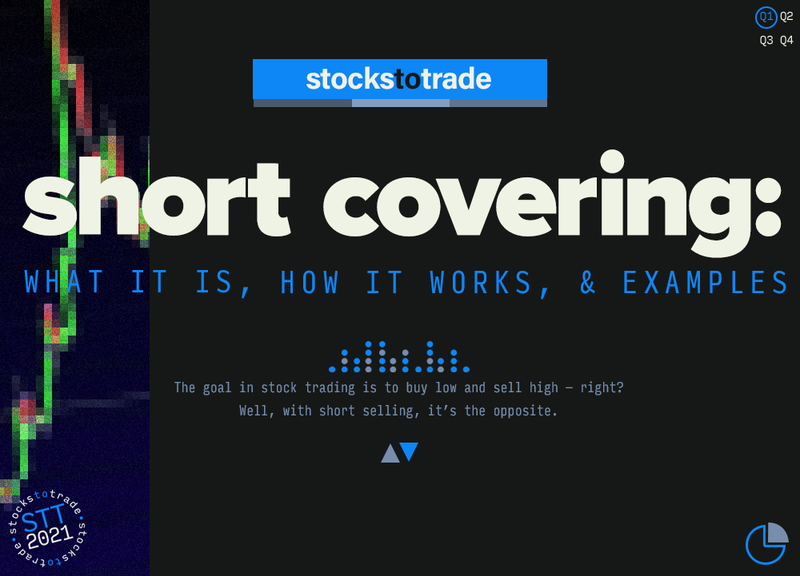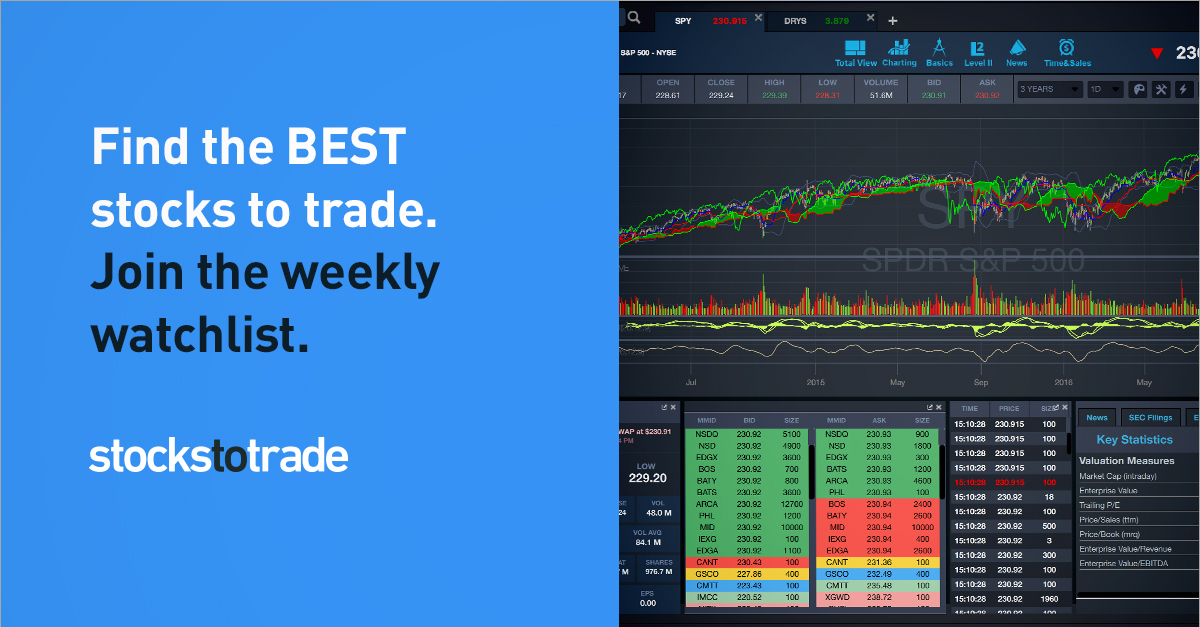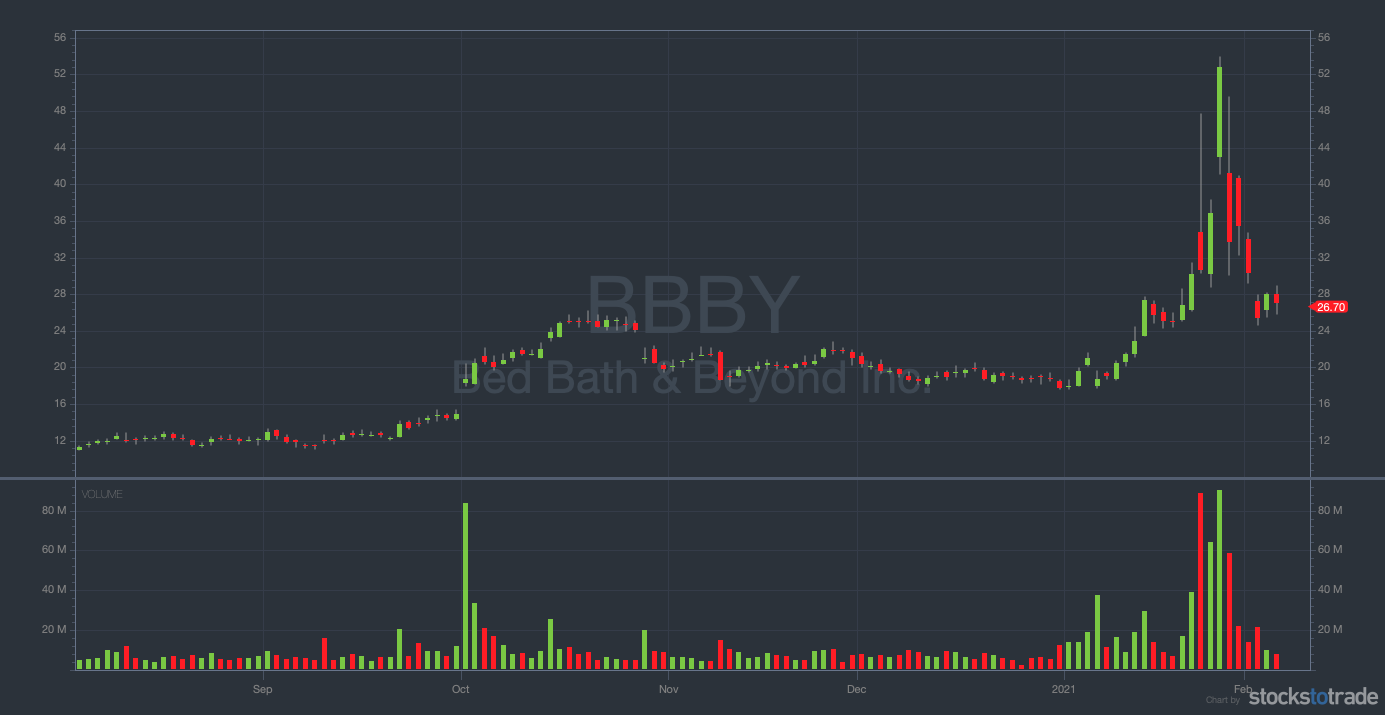There’s been a lot of talk about short selling and short covering lately…
This year’s meme stock saga shows why short covering is so important to understand. It seems like every week we see a stock with BIG short squeeze potential…
How can you track the top potential short squeeze opportunities before they happen? Simple. With the scanners and screeners on the StocksToTrade platform. You can take it for a test drive today — a 14-day trial is just $7.
And to catch the hottest news that can drive big market moves and short squeezes, get STT with the game-changing Breaking News Chat add-on for $17.
Now, let’s get into all things short covering and what it means for everyday traders like you.
Table of Contents
- 1 What Is Short Covering?
- 2 Why Is Short Covering Important for Traders to Understand?
- 3 Advantages and Disadvantages of Short Covering
- 4 How Does Shorting a Stock Work?
- 5 Tips on Closing a Short Position
- 6 Example of Short Covering: Bed Bath & Beyond Inc. (NASDAQ
- 7 Frequently Asked Questions About Short Covering
- 8 The Bottom Line
What Is Short Covering?
The goal in stock trading is to buy low and sell high … right? Well, with short selling, it’s the opposite.
Short sellers sell borrowed shares into the market in hopes of buying those same shares back for a cheaper price. So to close out their positions, they need to buy.
Short covering is when short sellers buy back those borrowed shares to close out their positions.
What’s the Difference Between a Short Build-Up and Short Covering?
A short build-up is a term used in options trading. It means traders expect a stock’s price to go down and new short positions to enter the market.
As the volume of options contracts climbs, the stock will continue to fall.
Options trading is ENTIRELY different from trading stocks. I don’t recommend beginning traders start options trading without doing a lot of research beforehand — it can be a complicated game.
Why Is Short Covering Important for Traders to Understand?
Short covering can have major implications for the market, even if you’re not a short seller.
Imagine you’re trading a stock and you see it’s being shorted … What do you do? How do you plan your exit? When will the short covering begin?
The best way to prepare for a situation like this is to study the past. That can help you recognize what’s going on so you can put together a trading plan with an exit strategy.
You may also be able to identify when shorts will need to start covering their positions. If you learn to recognize potential short squeeze opportunities, you could have an edge.
The more tools you can add to your toolbox, the better. Especially in today’s volatile markets. Building a solid trading plan has never been more important.
Advantages and Disadvantages of Short Covering
In trading, there’s always the potential for profit…
Traders can take profits when short selling without having to resort to short covering. Shorts take profits on a short sale or stop out by buying shares back. This also increases supply, so there’s the potential to push a stock down … Not so bad for short sellers, right?
But buying shares for short covering has a different effect on the market than trading through regular buy orders. If enough people buy at once, that’s a surge in demand — which can eat into profits.
Or worse … it could trigger a short squeeze.
A squeeze happens when several short sellers are stopped out at the same time. They all try to buy to close their positions. The rise in demand causes the stock price to surge.
How Does Shorting a Stock Work?
Let’s say you see some signs that a stock may be heading lower…
You decide to short the stock. So you borrow shares from a broker and sell them to the market. It’s the opposite of going long — selling before buying.
Since you borrowed the shares, you take on a negative position when you sell them. At some point, you need to return those shares to your broker. So you’ll buy them back, return them, and keep any profit — or absorb any loss. That’s how short selling works.
When you begin buying back those shares you borrowed, you’re short covering.
Tips on Closing a Short Position
Short selling is risky. Here are some tips to help you protect yourself.
Tip #1: Have a Plan
I talk about this A LOT on my daily Pre-Market Prep sessions and on the SteadyTrade podcast…
Whether you’re trading long or short selling, you have to go into every trade with a plan.
Creating a solid trading plan, including an entry and exit strategy, is part of every professional trader’s daily routine. If you’re prepared for the worst, you can act while others are panicking. And if you’re prepared for the best, you can take advantage when others won’t.
In short selling, it’s especially important to craft a well-thought-out trading plan and stick to it. Short selling is a lot riskier than opening a long position — there’s much more to lose. Sticking to a solid trading plan can help you limit your losses.
Tip #2: Don’t Be Greedy
Short selling and short covering come with a lot of risk.
When you enter a long position on a stock, you can only lose what you put in. When short selling, your losses could be much larger. If a stock price continues to climb, you continue to lose money. That’s why it’s important to take profits when you can and cut your losses early.
It’s better to be safe than sorry. Don’t be greedy. Sometimes taking a small loss can be a win…
Tip #3: Stay Up to Date
Stocks move fast in this market. You don’t want to get caught off guard. When shorting a stock, you want to watch the price action carefully.
Check the charts, monitor market news, and set price and volume alerts. You can’t be at your screen every second, and you can’t exit your position without knowing what’s going on, right? You need alerts.
StocksToTrade’s Breaking News Chat has been a game-changer for many traders since its launch last year. Two market pros keep tabs on the news and alert you right away to the developments that move stocks. It’s an add-on feature with StocksToTrade. Try both for 14 days for just $17.
Tip #4: Risk Management
Risk management is crucial, especially when short selling. If you’re a newer trader, your main goal should be to stay in the game and grow your skills.
Managing risk is a major part of any good trading plan. Shorting a stock could leave you with huge losses if a trade doesn’t go your way.
If you stick to a trading plan and cut losses early, you’re more likely to live to see another day.
Taking losses is part of trading. It happens. The key is to minimize your losses and your risk.
Example of Short Covering: Bed Bath & Beyond Inc. (NASDAQ: BBBY)
Bed Bath & Beyond Inc. gave us a classic example of a short squeeze in January when it got caught in the GameStop (NYSE: GME) frenzy.
BBBY climbed from around $16 to over $27, and short sellers were forced to begin short covering. This caused the stock to surge from just under $25 to almost $55 in just a few days.
With a big spike in volume, amateur traders pouring in, and shorts beginning to cover their positions, BBBY became the perfect storm for a short squeeze.
Frequently Asked Questions About Short Covering
What Happens if You Can’t Cover a Short?
Your broker may force the closure of your position. That’s why you need to know your risk and set stop-loss limit orders.
What Is a Short-Covering Rally?
Short sellers profit when a stock’s price falls. If the stock rises, they lose. That’s why short sellers rush to buy back shares when a stock begins to surge. The more they buy, the higher the stock climbs. That’s a short-covering rally.
How Do You Know If a Stock Is Shorted?
Most websites that offer stock price quotes also have general shorting information about stocks. Major stock exchanges have more specific short-interest data.
Is Short Covering Good?
That depends. If you’re a short seller, probably not. If you’re a long or position trader? You probably love when short sellers are caught in a squeeze and forced to cover! These rallies can send stocks to all-time highs.
The Bottom Line
Well, that’s short covering in a nutshell.
Even if you’re not planning on short selling, short covering is an important concept to keep in mind in today’s markets.
In my 15 years of trading, I don’t think I’ve ever seen so much volatility for this long. Stocks move fast — and that’s an understatement.
It’s never too early to take profits or cut your losses. So remember to be safe, make a solid trading plan, and respect your stop losses.
And if you think you’re ready to take your trading game to the next level, be sure to check out the SteadyTrade Team. It’s a great community of traders. We work together every day, figuring out the top moves in the market. Sign up today! I’ll see you in the SteadyTrade Team chat room.
What do you think of short covering? Are you a short seller? Leave a comment below!




